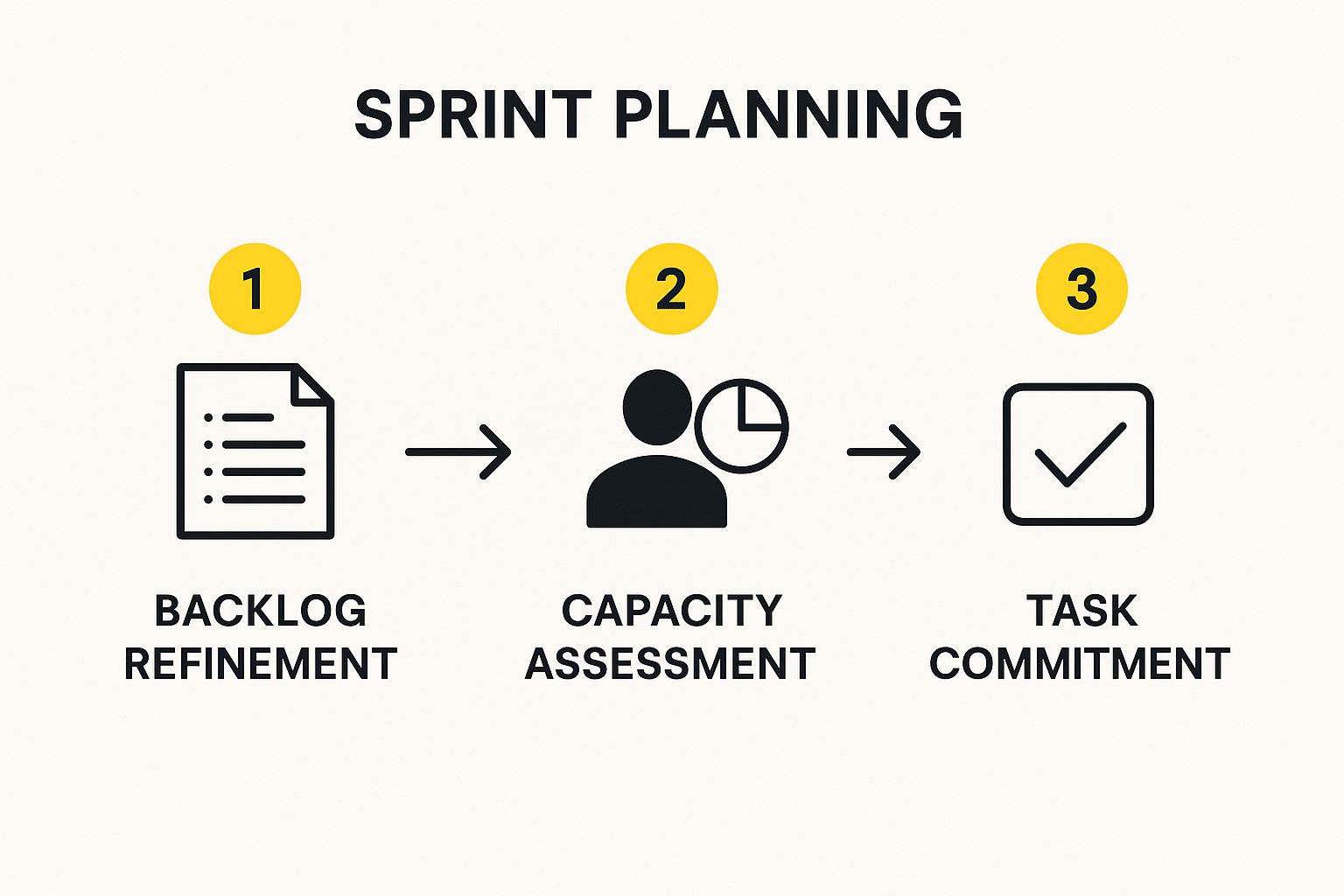Sprint planning is so much more than just another meeting on the calendar. When it’s done right, it’s the engine that drives a predictable, productive sprint. This is where your team comes together, locks in a clear goal, and builds a realistic plan to deliver real value. Essentially, you’re turning a wish list from the product backlog into a concrete, actionable to-do list for the next couple of weeks. When everyone walks out of that room, they should be on the exact same page about what they’re building and how they’re going to get it done.
Building the Foundation for Predictable Sprints

Here’s a secret I’ve learned over the years: a great sprint planning session is won or lost long before the meeting ever starts. The real work happens in the days leading up to it. If you walk in unprepared, you’re setting yourself up for a chaotic, rambling discussion that goes nowhere. The single most important piece of that preparation? A healthy product backlog.
Think of your backlog as the foundation of your sprint. If it’s a mess—full of vague user stories, oversized epics, or outdated requests—your planning meeting will sink. The Product Owner really owns this, making sure the backlog is prioritized, refined, and ready for the team to look at.
But it’s not a one-person show. The best preparation is a team effort. The Development Team has to weigh in on the technical side of things and give effort estimates, while the Scrum Master keeps the refinement conversations on track and productive.
Cultivate a Well-Refined Product Backlog
A truly effective backlog is often described as DEEP: Detailed appropriately, Estimated, Emergent, and Prioritized. This just means the items at the top of the list—the ones you’ll likely tackle soon—are small, clearly understood, and have solid acceptance criteria.
The stuff way down at the bottom can stay a bit fuzzy. That’s fine. But the work for the next sprint needs to be crystal clear. Getting this done ahead of time prevents your planning meeting from turning into a frantic, last-minute grooming session, which is a massive time-waster and a huge source of team frustration.
Of course, to build this foundation, you first have to know what game you’re playing. A big part of predictability comes from choosing between Kanban and Scrum for agile success, as this decision fundamentally shapes how you plan and execute work.
Establish a Rock-Solid Definition of Done
What does “done” actually mean to your team? If you don’t have a shared answer, chaos ensues. One developer’s “done” is another’s “it’s ready for QA,” and that gap is where problems hide. A Definition of Done (DoD) is your team’s formal agreement on what it takes to call a piece of work complete.
The Definition of Done is the ultimate checklist for your work. It’s the team’s commitment to quality, ensuring that every completed item provides real, usable value. It removes ambiguity and prevents the dreaded “it works on my machine” problem.
Your DoD should be a living checklist that might include things like:
- Code has been peer-reviewed.
- Unit tests are written and passing.
- The work is merged into the main branch.
- All necessary documentation is updated.
- The feature has passed QA testing.
A strong DoD isn’t set in stone; it should evolve as your team and product grow. It’s absolutely non-negotiable for shipping high-quality work predictably.
Use Velocity as a Guide, Not a Weapon
Velocity is a fantastic tool for forecasting. By looking at the average amount of work your team has completed in past sprints, you can make a pretty educated guess about what you can realistically chew through in the upcoming one.
But handle it with care. Velocity is a guide for a conversation, not a hammer to demand more output. It’s there to help answer the question, “Based on what we’ve done before, what feels achievable now?” Never, ever use it to compare teams or pressure developers into overcommitting. That’s a fast track to burnout, sloppy code, and a miserable team.
These foundational practices are more critical than ever. We’ve seen agile adoption in software development teams explode, jumping from 37% to 86% between 2020 and 2021, with Scrum leading the charge. This massive industry shift shows just how vital it is for modern teams to master the art of agile sprint planning.
How to Run a Sprint Planning Meeting That Actually Works
Sprint planning is where the rubber meets the road. This is the moment a product backlog—which is really just a wish list—gets turned into a concrete, actionable plan for the next couple of weeks. The whole session boils down to answering two fundamental questions: “What can we get done?” and “How are we going to do it?”
A well-run sprint planning agile meeting is a masterclass in collaboration. It all kicks off with the Product Owner, who sets the stage by presenting the top-priority items from the product backlog. This shouldn’t be a dry reading of a list. A good PO tells a story, explaining the why behind each item and how it fits into the bigger picture. The idea is to start a conversation, not just hand out assignments.
Defining Your Sprint Goal
The first concrete thing to come out of this discussion should be a solid Sprint Goal. Think of it as the North Star for your sprint. It’s a simple, one-sentence summary of what the team is trying to accomplish. This isn’t just a jumble of backlog items; it’s the single, cohesive objective that makes sense to anyone, even a stakeholder who pops in to ask what you’re up to.
For example, a strong Sprint Goal could be: “Implement a secure, one-click checkout for returning customers to cut down on cart abandonment.” It provides crystal-clear purpose. This clarity is what helps the team make smart decisions when, inevitably, something unexpected comes up mid-sprint. It’s what unites the Development Team around a shared mission, rather than just closing tickets.
The Sprint Goal is the heart of the sprint. It gives you flexibility on the exact features you implement while making sure the team delivers something coherent and valuable. Without a goal, a sprint is just a random collection of tasks.
Once the “What” is framed by a clear goal, the conversation naturally shifts to the “How.” This is the Development Team’s time to shine. They are the experts in getting things done, and it’s their job to figure out how much work they can realistically take on. This is where the whole process of agile project development truly comes alive, linking high-level strategy with the day-to-day work.
Committing to the Work
Now, the Development Team starts pulling items from the top of that prioritized backlog and moving them into the Sprint Backlog. They select work they feel confident they can finish to hit the Sprint Goal, using their past velocity and current capacity as a reality check. This part is a negotiation, not a directive. The Product Owner might hope for 10 items, but if the team’s capacity points to seven, then seven it is. The final say on the forecast belongs to the people who will actually do the work.
This is also where a good Scrum Master proves their worth. Their role is to protect the team from overcommitting—a classic mistake that leads straight to burnout and shoddy work. An effective facilitator keeps the conversation on track, makes sure everyone is heard, and helps the team break down big user stories into smaller, more manageable tasks right then and there.
This flow chart gives you a good visual of how these activities connect to build a solid plan.

As the visual shows, commitment is the final piece of the puzzle, built on a foundation of a well-groomed backlog and a realistic look at the team’s capacity. By the time the meeting wraps up, every single person on the team should feel a sense of ownership. They don’t just understand their tasks; they believe in the goal and feel confident they can nail it together. That shared commitment is the real sign of a successful sprint planning session.
The Art of Realistic Estimation and Capacity Planning

Let’s be honest: estimation in the agile world isn’t about gazing into a crystal ball. It’s about getting the team to have the right conversations about the work ahead. We’re aiming for a shared understanding, not a scientifically precise prediction. This skill is what separates wild guesswork from informed forecasting.
This process is a cornerstone of sprint planning agile methods. It’s how you take a list of priorities and turn it into a realistic goal for the next sprint. If you skip this part, you’re essentially flying blind, which is a fast track to overcommitment and burnout.
Moving Beyond Hours to Story Points
One of the first big mindset shifts for many teams is getting away from estimating in hours. It feels intuitive, but it’s a trap. Time-based estimates are notoriously unreliable because they don’t account for complexity, interruptions, or just plain uncertainty. What a senior dev can knock out in five hours might take a junior developer two days.
This is exactly why we use story points. They’re a relative unit of measure that captures a mix of things:
- Effort: How much actual work is this?
- Complexity: How hard is it to figure out and build?
- Risk & Uncertainty: What are the unknowns? What could go wrong?
Instead of asking, “How many hours will this take?” the team asks, “How big is this compared to other work we’ve done?” This approach is far more stable and way less stressful. A ‘5’ is roughly half the size of a ’10’, and that’s true no matter who on the team picks up the task.
Popular Agile Estimation Techniques
There are a few solid methods for assigning story points. The trick is to find one that clicks with your team and, most importantly, gets them talking.
Planning Poker is a classic for a reason. It’s collaborative and engaging. Every team member gets a deck of cards with Fibonacci numbers (0, 1, 2, 3, 5, 8, 13…). After a quick discussion about a user story, everyone picks a card that represents their estimate and reveals it at the same time.
If the numbers are close, you agree on one and move on. But when there’s a big gap—like one person voting a ‘3’ and another an ‘8’—that’s where the magic happens. It forces a conversation. The person with the high estimate and the person with the low one explain their thinking, often uncovering hidden complexities or simpler approaches that no one else saw.
For bigger backlogs, T-shirt Sizing is another great tool, especially during initial refinement. It’s less granular, using sizes like XS, S, M, L, and XL to group items into rough buckets of effort. It’s a quick way to get a high-level view without getting bogged down in numbers too early.
The real value of estimation isn’t the number itself, but the conversation it forces. When team members have to defend their estimate, they uncover assumptions, clarify requirements, and identify risks before a single line of code is written.
Factoring in Real-World Capacity
Once your items are estimated, you need to figure out how many you can realistically pull into a sprint. This is where capacity planning is absolutely critical. Your team’s capacity isn’t static; it changes from one sprint to the next.
Your starting point is the team’s historical velocity—the average number of story points they’ve completed in past sprints. But that’s just a baseline. You have to adjust for reality:
- Vacations and Holidays: Is anyone taking time off?
- Company Meetings: Are there any all-hands or mandatory trainings scheduled?
- Other Commitments: Does the team have other duties pulling them away from project work?
For instance, say a five-developer team has an average velocity of 30 points. If one developer is on vacation for a whole two-week sprint, you should reduce your capacity forecast by 20%. That means aiming for around 24 points. Making this adjustment proactively saves everyone a lot of stress. To dive deeper into the nuances of this process, you might find our additional sprint planning tips and best practices helpful.
Scrum, the framework where all this happens, is still the dominant agile methodology out there. Research shows that 94% of agile practitioners use Scrum. With teams averaging about seven members and sprints lasting roughly 2.4 weeks, getting this planning right is non-negotiable for productivity. By blending relative estimation with honest capacity planning, your team can craft a sprint goal that’s both challenging and achievable—the key to a sustainable pace and consistent delivery.
Using Tools to Enhance Your Sprint Planning Workflow
While the heart of sprint planning will always be good old-fashioned collaboration and communication, the right tools act as the central nervous system connecting every part of the process. Moving beyond scattered spreadsheets or sticky notes into a dedicated project management tool isn’t just a matter of getting organized; it’s about creating a single source of truth that boosts visibility and accountability for the whole team.
These platforms aren’t just for ticking off tasks. When you use them right, they become powerful engines for the core conversations of sprint planning, from refining the backlog to figuring out team capacity. They turn abstract ideas into a tangible, interactive workflow everyone can rally behind.
For many agile teams, Jira is the default choice. Its entire structure is purpose-built for Scrum and other agile frameworks, making it a natural fit. But it’s not the only game in town—tools like Asana and Trello also offer powerful features that can be adapted for a smooth sprint planning workflow.
Mastering Sprint Planning in Jira
Jira is practically designed to mirror the agile sprint cycle, which is why so many teams gravitate towards it. The real trick is understanding how its features directly support the key activities that happen in your sprint planning meeting.
Here’s how you can actually use Jira to make your sprint planning agile process more streamlined:
- Get Your Backlog in Order: The backlog view in Jira is where it all begins. Before the meeting even starts, the Product Owner needs to have this prioritized, with the most critical user stories sitting right at the top. Every story should have an estimate in its story points field.
- Create and Configure the Sprint: Right from the backlog view, you can create a new sprint with a click. Give it a clear name that means something to the team (e.g., “Sprint 24 – User Profile Overhaul”) and set the start and end dates.
- Define the Sprint Goal: Don’t skip this! Use the “Sprint Goal” field to add that one-sentence objective the team just agreed on. This keeps the goal visible to everyone throughout the entire sprint.
I see this all the time: teams treat the sprint goal as an afterthought. Make it a non-negotiable step to fill out the goal field in Jira before you hit “Start Sprint.” It’s a small action that keeps the team’s primary objective front and center on their board, every single day.
Visualizing the Plan and Tracking Progress
Once the sprint is ready to go, the team can literally drag and drop issues from the backlog into the new sprint. Jira is smart enough to automatically total the story points, giving you a real-time, no-nonsense view of the committed workload. This instant visual feedback is crucial for preventing the all-too-common problem of overcommitment.
Here’s a look at what a typical Jira board might look like, showing the backlog, the active sprint, and the workflow columns.
This dashboard gives you an immediate, at-a-glance overview of the plan. It helps the team truly grasp the scope and see how things are progressing.
After the meeting, this Jira board becomes the team’s daily command center. As work gets done, cards move from “To Do” to “In Progress” and, finally, to “Done.” The burndown chart, a native Jira report, visually tracks your work against the plan. It’s a powerful way to see if you’re actually on track to hit that sprint goal.
If you’re curious about the methodologies behind these processes, it’s worth diving deeper into the nuances of the agile approach.
Exploring Other Agile Tools
Jira is a powerhouse, but it’s not the only option out there. Different tools are built for different team vibes and needs:
- Asana: This is a fantastic choice for teams who value a clean, intuitive interface. You can use its “Boards” view to mimic a Kanban or Scrum board perfectly and add custom fields to track things like story points and priority.
- Trello: Trello is the king of visual simplicity. Its card-based system is perfect for straightforward sprint planning. Just be aware that you might need to lean on add-ons (they call them Power-Ups) for more advanced features like story point estimations.
While specific agile tools are mission-critical, don’t forget that general productivity enhancers can make a big difference for individual focus. It’s often worth encouraging team members to explore the top productivity Chrome extensions) to see what clicks for them.
Ultimately, the best tool is the one your team will actually use consistently. The goal is to find a platform that supports your process, sparks collaboration, and makes your sprint planning more effective.
Common Sprint Planning Mistakes to Avoid

Even the most seasoned agile teams can slip into bad habits. A truly successful sprint planning agile process isn’t just about ticking boxes on an agenda; it’s about knowing which pitfalls to sidestep. Think of this as your field guide to spotting and correcting the anti-patterns that lead to missed goals and team frustration.
One of the most common issues I see is teams simply showing up unprepared. This usually starts with a Product Owner who hasn’t thoroughly refined the backlog. What happens next is predictable: the planning meeting turns into a frantic, last-minute grooming session. The team is left trying to understand and estimate poorly defined user stories on the spot, which is a massive waste of everyone’s time.
Neglecting the Product Backlog
A messy or poorly prioritized product backlog is the single biggest culprit behind failed sprint planning. When the items at the top are vague, too large, or lack clear acceptance criteria, the team has no real shot at making an accurate forecast. This is a direct path to a sprint filled with confusion, scope creep, and rework.
The fix is straightforward but requires discipline: hold dedicated backlog refinement sessions. These aren’t just “nice-to-haves.” Treat them as a non-negotiable part of your sprint cadence. This ensures that every piece of work is genuinely “ready” before it ever comes up for sprint consideration.
Another classic mistake is overcommitting. It’s a trap that’s easy to fall into, often fueled by optimism or pressure from outside the team. When teams consistently pull in more work than their historical velocity can support, they’re just setting themselves up for failure. This inevitably leads to burnout, a dip in quality, and a serious blow to morale when sprint after sprint ends in failure.
The goal of a sprint isn’t just to be busy. It’s to deliver a valuable, “Done” increment of the product. Overcommitment is the enemy of predictability and quality, forcing teams to cut corners just to hit an unrealistic target.
To fight this, your team has to start treating its historical velocity as a realistic guide, not a high score to beat every single sprint. Capacity planning needs to be an honest conversation that accounts for real-world things like holidays, company meetings, and other commitments. This is where the Scrum Master is key—they need to shield the team from pressure to take on more than is feasible.
Treating the Sprint Goal as an Afterthought
So many teams fall into the trap of picking a bunch of backlog items and then trying to reverse-engineer a “goal” that fits. This backward approach completely neuters the power of the Sprint Goal. Without a clear, unifying objective, a sprint is just a random collection of tasks.
The Sprint Goal should be the first thing you establish. It should be a short, compelling objective that guides every single decision during the sprint. For example, instead of a goal like “Finish stories X, Y, and Z,” a much better goal would be, “Allow users to securely save payment information for faster checkout.”
This approach provides focus. It empowers the team to make smart trade-offs when—not if—unexpected problems arise. It’s the difference between just closing tickets and delivering a coherent, valuable piece of functionality.
Allowing the Plan to Become Too Rigid
While the Sprint Goal should be set in stone, the plan to achieve it—the Sprint Backlog—is a different story. It can and should adapt. After all, agile is about responding to change. Sometimes the team discovers a chosen technical path is a dead end, or a much simpler solution presents itself mid-sprint.
A common anti-pattern is treating the initial sprint plan like an unbreakable contract. This kind of rigidity kills creativity and stops the team from learning as they go. The Development Team needs the autonomy to adjust the “how” as long as they stay true to the “what” defined by the Sprint Goal.
Finally, failing to learn from your past mistakes is a critical error. The insights from your sprint retrospective are gold, but they’re worthless if they don’t lead to action. If your retros repeatedly bring up the same roadblocks, it’s a clear sign that you aren’t closing the feedback loop. Using a good sprint retrospective template can make a world of difference here, providing a structured way to turn lessons learned into concrete improvements for the next sprint. By actively avoiding these common traps, you’ll build a more resilient, effective, and predictable agile process.
Common Questions About Sprint Planning (And Straight Answers)
Even the most seasoned agile teams run into tricky situations during sprint planning. You can have a great process on paper, but the reality is often messy.
Let’s walk through some of the questions I hear all the time from teams. Getting these right can be the difference between a sprint that hums along and one that gets bogged down from day one.
How Long Should a Sprint Planning Meeting Be?
The official Scrum Guide gives you a pretty generous time-box: a maximum of two hours for every week of your sprint. So for a typical two-week sprint, you get up to four hours. For a one-week sprint, you cap it at two.
But here’s the crucial part: this is a cap, not a target. If your team consistently uses the entire four hours, that’s a red flag. It almost always means you aren’t doing enough backlog refinement before the meeting.
A well-prepared team with a healthy, refined backlog can often get a solid sprint plan locked in much faster.
A sprint planning meeting that feels rushed or drags on forever isn’t a sign you need a longer meeting. It’s a symptom of poor preparation. The fix is a better-prepared team and a well-groomed backlog.
Who Decides How Much Work to Pull into a Sprint?
This is a big one, and the answer is non-negotiable in a healthy Scrum environment: the Development Team decides. They, and only they, have the final say on how much work they can realistically forecast for the upcoming sprint.
The Product Owner owns the “what”—they prioritize the work based on value. But the team are the experts on the “how much.” They look at their historical velocity and current capacity to make a forecast.
The Scrum Master’s job is to fiercely protect this principle. They ensure the team isn’t bullied or pressured into overcommitting, whether by stakeholders or a well-meaning but overly ambitious Product Owner. This ownership is key to building a motivated, accountable team.
Can We Change the Sprint Goal After the Sprint Starts?
In short, no. Once the sprint is underway, the Sprint Goal is locked. It’s the north star for the team, providing the stability and focus needed to build a valuable increment of work.
That doesn’t mean the plan is rigid. The Sprint Backlog can and often does change. The team might discover a better technical approach or realize an item is way more complex than they first thought. They are free to adjust the how they achieve the goal.
However, the overarching goal itself should not be changed.
If something so massive happens that the Sprint Goal becomes completely irrelevant, the Product Owner has the authority to cancel the sprint. This is a drastic step and should be a rare event, but it’s the right move to avoid wasting the team’s effort on work that no longer delivers value.
Understanding how sprint planning connects to the other ceremonies is vital. Once you’ve planned the work, you also need to perfect how you review it. For more on that, check out our guide on how to master sprint reviews with NASA Agile Meetings for Teams.
At resolution Reichert Network Solutions GmbH, we’ve built our tools around the idea that structured communication is the key to effective agile meetings. NASA – Not Another Standup App embeds agendas, timers, and collaborative features directly into Jira to make sure your ceremonies are focused and produce real outcomes. Discover how NASA can elevate your team’s agile practices today.
